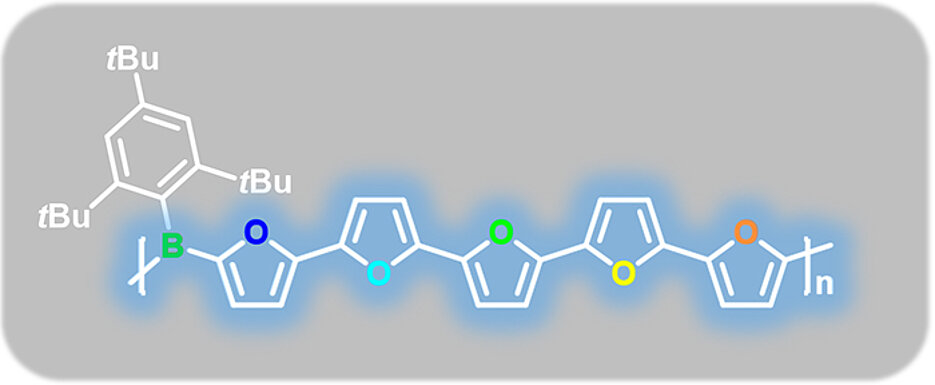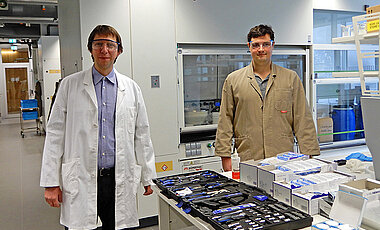Sustainable Chemistry Based on Wood
02/15/2022Producing materials for solar cells, light-emitting diodes and other organic electronics applications as sustainably as possible: A team from Würzburg's Faculty of Chemistry is working on this.

Some hikers carry a small solar power plant with them: a foil is attached to their backpack that converts sunlight into electricity. This allows them to charge their mobile phone while on the move. Flexible, thin and lightweight solar panels can also be attached to outdoor clothing or glued to curved surfaces - such as the roofs of mobile homes.
Such solar cells capture the sun's energy not with crystalline silicon, but with special organic materials. Unfortunately, these materials have so far been made from crude oil or natural gas - and that is not in the spirit of sustainability.
That's why scientists are looking for alternatives. The team led by chemistry professor Holger Helten from the Julius-Maximilians-Universität (JMU) Würzburg in Bavaria, Germany, has a focus on the renewable raw material wood. Furans can be derived from wood, and these ring-shaped molecules are very suitable for organic electronics: they can be used for solar cells, light-emitting diodes, displays or electronic circuits.
Boron stabilises furan-based polymers
Crucially, furan-based materials have much better properties for many applications than most materials used in organic electronics to date. Compared to standard thiophene-based materials, they have, among other things, a stronger luminosity and are more soluble - this simplifies their processing and saves solvents. Furans are also biodegradable, which is why such materials can probably be recycled.
Unfortunately, most furan-based materials are very unstable under ambient conditions; they decompose quickly in the presence of oxygen and light. But they can be stabilised by linking them with the element boron. "This produces compounds that can withstand temperatures of up to 300 degrees Celsius and remain unharmed by light for months," says JMU chemist Maximilian Fest, who is doing his doctoral thesis under Professor Helten.
Environmentally friendly synthesis methods in use
Research into boron-containing polymers is still in its infancy. The Würzburg doctoral student is synthesising various new variants from boron and furans and characterising their properties. In doing so, he relies on environmentally friendly synthesis methods that are being developed in his professor's working group.
Holger Helten explains why these methods are environmentally friendly: "The polymerisation of boron and furans, but also the synthesis of purely organic polymers, usually produces very questionable waste products. Often these are organic tin compounds that are highly toxic to humans and the environment. With our approach, no metals are needed and no toxic waste is produced."
His team wants to further improve these synthesis processes, to make them even more sustainable. One goal is to reduce the number of reaction steps - which saves energy and reagents.
Funded by the German Federal Environmental Foundation
With all these plus points in terms of sustainability, it is not surprising that the German Federal Environmental Foundation (Deutsche Bundesstiftung Umwelt, DBU) is funding Maximilian Fest's dissertation project: It is granting him a scholarship of 1,500 euros a month for 2.5 years plus material resources.
The incorporation of boron into furan-based polymers opens up many other possibilities beyond organic electronics. "We can use it, for example, to build sensors that detect toxic amines and other substances," says Professor Helten. Such polymers can also be used as catalysts for chemical reactions or as electrode materials for lithium-ion batteries.
About the person: Professor Holger Helten
Sustainability in chemistry and research into inorganic-organic hybrid materials: these are two focal points in the team of Holger Helten, who studied chemistry at JMU. After working at the universities of Bonn and Bristol (UK), Helten went to RWTH Aachen University in 2012 as head of an Emmy Noether junior research group, funded by the German Research Foundation (DFG).
There he later headed a Heisenberg research group. In 2019, he moved to JMU as a Heisenberg professor; here he heads the Chair of Inorganic Chemistry I. With the prestigious Heisenberg professorships, the DFG funds outstanding researchers. Helten is a member of the division of "Sustainable Chemistry" of the German Chemical Society (GDCh).
Contact
Prof. Dr. Holger Helten, Institute of Inorganic Chemistry and Institute for Sustainable Chemistry and Catalysis with Boron (ICB), University of Würzburg, T +49 931 31-84086, holger.helten@uni-wuerzburg.de







